Field Guide to Shipping Containers
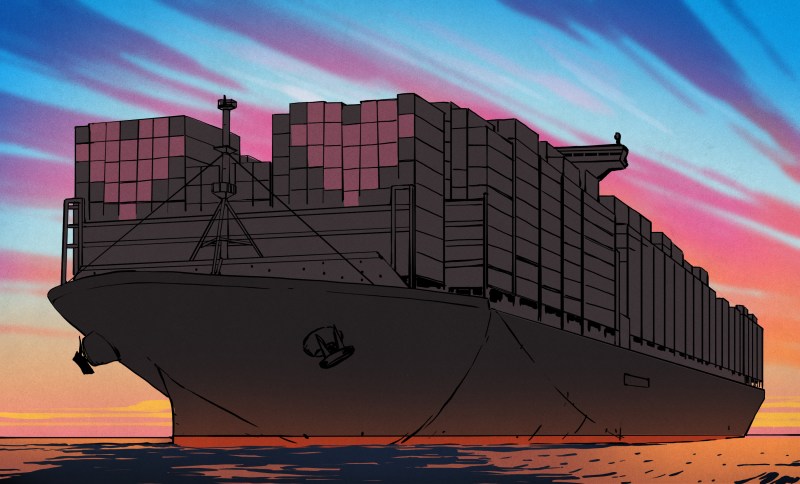
In the 1950s, trucking magnate Malcom McLean changed the world when he got frustrated enough with the speed of trucking and traffic to start a commercial shipping company in order to move goods up and down the eastern seaboard a little faster. Within ten years, containers were standardized, and the first international container ship set sail in 1966. The cargo? Whisky for the U.S. and guns for Europe. What was once a slow and unreliable method of moving all kinds of whatever in barrels, bags, and boxes became a streamlined operation — one that now moves millions of identical containers full of unfathomable miscellany each year.
When I started writing this, there was a container ship stuck in the Suez canal that had been blocking it for days. Just like that, a vital passage became completely clogged, halting the shipping schedule of everything from oil and weapons to ESP8266 boards and high-waist jeans. The incident really highlights the fragility of the whole intermodal system and makes us wonder if anything will change.
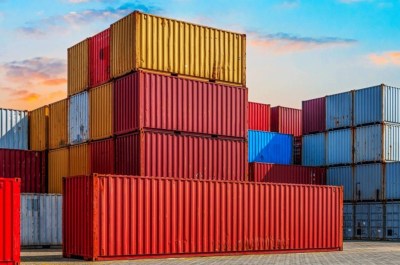
Setting the Standard
We are all used to seeing the standard shipping container that’s either a 10′, 20′, or 40′ long box made of steel or aluminum with doors on one end. These are by far the most common type, and are probably what come to mind whenever shipping containers are mentioned.
These are called dry storage containers, and per ISO container standards, they are all 8′ wide and 8′ 6″ tall. There are also ‘high cube’ containers that are a foot taller, but otherwise share the same dimensions. Many of these containers end up as some type of housing, either as stylish studios, post-disaster survivalist shelters, or construction site offices. As the pandemic wears on, they have become so much in demand that prices have surged in the last few months.
Although Malcom McLean did not invent container shipping, the strict containerization standards that followed in his wake prevent issues during stacking, shipping, and storing, and allow any container to be handled safely at any port in the world, or load onto any rail car with ease. Every bit of the container is standardized, from the dimensions to the way the container’s information is displayed on the end. At most, the difference between any two otherwise identical containers is the number, the paint job, and maybe a few millimeters in one dimension.
Standard as they may be, these containers don’t work for every type of cargo. There are quite a few more types of shipping containers out there that serve different needs. Let’s take a look at some of them, shall we?
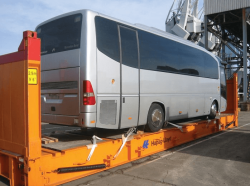
Flat Rack Container
Flat rack containers are basically platforms with no walls or roofs that are used to transport things like pipes, machinery, timber, buses, and boats. In other words, anything large or bulky that needs to be loaded and unloaded from the top.
Some flat rack containers have collapsible sides that make the cargo easy to remove, and others’ sides are fixed in place. Collapsible flat racks can be stacked together — a stack of four is about the size of a dry storage container. Flat racks come in both 20ft and 40ft sizes, though the widths and heights are often similar between the two.
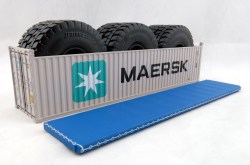
Open Top Container
There are a lot like dry storage containers, except they have either a tarp on the top or a convertible lid that can be taken off completely to accommodate shipments of any height, including massive tires.
The short sides double as doors, so there are a couple of options when it comes to loading and unloading cargo.
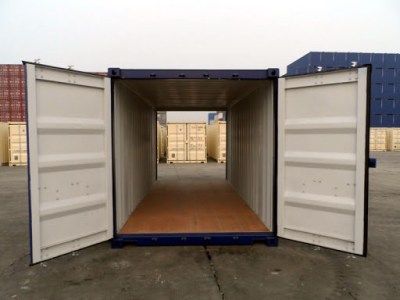
Tunnel Container
Also called double-door containers, tunnel containers are basically dry storage containers that open at both ends instead of just one. This makes it really easy to load and unload the shipment, or if the container is being used as a temporary warehouse, to get to a piece of stored cargo that would otherwise be stuck in the back of the container.
As you might expect, tunnel containers come in 20- and 40-foot lengths. They are usually made of steel and have plywood floors.
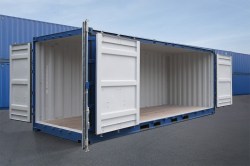
Open Side Storage Container
These are a lot like tunnel containers except that only one of the short sides has doors, and one of the long sides can be opened to accommodate wide things. This design is also useful for helping to locate specific cargo without having to unload too much of the container.
Many types of containers have forklift pockets so they can be easily moved around when empty. You can clearly see the forklift pockets around the bottom of this open side storage container.
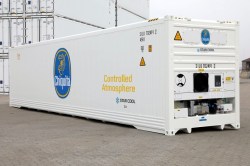
Refrigerated or “Reefer” Container
Reefer containers are used for shipping things like produce and other perishable items at consistent temperatures over long distances. They are typically air-cooled or water-cooled, though some of them come with a generator.
These containers are the reason that I can get oranges and apples year round, despite living in the Midwest. They’re also used for items like fresh flowers and pharmaceuticals.
The container pictured is designed to transport bananas, which must be kept away from oxygen lest they begin to ripen. It has a controlled atmosphere system that can keep bananas green for up to 45 days.
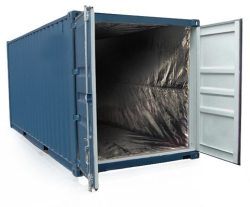
Insulated Container
Not all perishables have to be actively refrigerated during shipping, but they do need to be kept within a specific temperature range. Some things like apples or certain types of pharmaceuticals will do fine in an insulated or thermal container.
Insulated containers also serve the purpose of safeguarding the cargo from outside air contaminants by running it through a filter first. Some insulated containers have dual walls like a Thermos, and others are simply lined with thermal blankets.
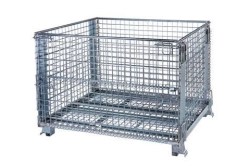
Cargo Storage Roll Container
These are specialized containers for transporting sets or stacks of things. They have rollers on the bottom that make them easier to move around, and the whole thing can fold up for storing and stacking.
Cargo storage roll containers are usually made from strong wire mesh and come in different colors.
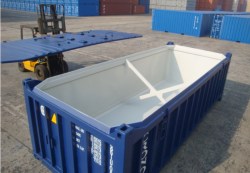
Half-Height Container
Half-height containers are basically dry storage containers that are half as tall, and can be either open-topped or closed.
These are usually used to move things like coal, stones, and other heavy, pour-able cargo that calls for easy loading and unloading. They’re also used for vehicles, heavy equipment, or anything else that fits inside. The lower center of gravity makes them quite useful for heavy loads.

Car Carriers
Yep, you guessed it — these are for transporting cars and other vehicles. If you buy a car overseas, it has to get to you somehow.
Many car carriers have a ramp and two levels of racks so they can be stuffed with cars without wasting any space.
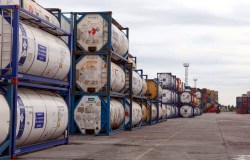
Tanks
Tank containers are giant steel cylindrical tanks with frames built around them. They’re used for shipping all kinds of liquids from molasses to gasoline.
Each tank container can carry 21,000 to 40,000 liters of whatever types of liquids it is designed to store.

Intermediate Bulk Containers
These are a class of specialized container that holds everything from liquids to solids. They are typically used for shipping goods like chemicals, food syrups, paints, and raw materials. IBCs are called intermediate because they are smaller than tanks but larger than drums.
Some containers are rigid, and others are flexible and fold up for storage when empty. IBC containers have only been around for about thirty years.

Drums
We’ve all seen these before, though there are many types beyond the 55-gallon drum. Drums are usually made from steel, hard plastic, or dense paperboard, depending on the intended use.
Drums are handy containers for many liquids and powders because they can be rolled, moved around with a hand truck, or stacked together on pallets for easily shifting groups of them around with a forklift.
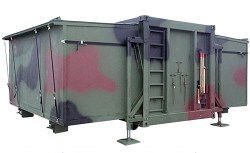
Special Purpose Containers
These are unique, sometimes one-off containers that are often used for high-profile shipments like weapons and military cargo. Because of this, they are often heavily secured.
Unlike most other standardized containers, these come in many shapes and sizes and are made of whatever materials suit the special purpose.

Swap Bodies
These are mostly used in Europe and have a strong bottom with the convertible top, so they can ship many kinds of items.
Swap body containers are typically only used on trucks and trains and don’t ride on container ships. Instead of a sturdy base with forklift pockets, these have spindly folding legs on the corners to support the container at a dock or between truck and train.
A Container for Everything
These are some of the most common types of shipping containers out there aside from the metal box we’re all familiar with. Lots of cargo has special needs, but it can all be containerized one way or another.
So what is it like to receive a large shipment via container ship? Our own [Bob Baddeley] has firsthand experience and told us all about it a while back. Do you have any experience with shipping at this scale, or have you ever repurposed a shipping container? Let us know in the comments!
Post a Comment